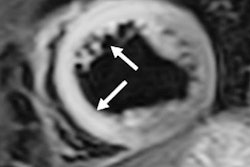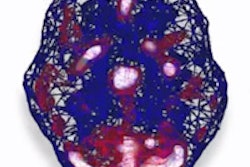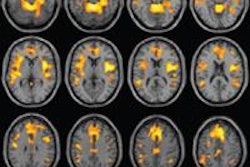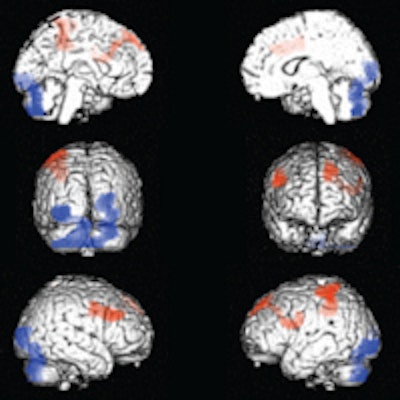
Dysfunction in the prefrontal cortex region of the brain caused by excessive cocaine use may be reversed to some degree after more than one month of abstinence, researchers from Uruguay have found.
SPECT images showed increased blood flow to brain regions associated with emotional control, memory, and other executive functions when users had stopped using cocaine for at least one month.
The findings are promising news for rehabilitation efforts, but lead author Dr. Rodolfo Ferrando cautioned that some brain dysfunction remains for now-abstinent cocaine users and longer periods of evaluation are needed to validate any positive results.
Ferrando, an associate professor at the Universidad de la República in Montevideo, presented the study at the recent Society of Nuclear Medicine and Molecular Imaging (SNMMI) annual meeting in Baltimore.
Cocaine epidemic
Of particular concern in Ferrando's region of Uruguay is the use of a form of cocaine known as cocaine base paste (CBP), which is smoked. Users can become severely dependent on CBP and commit crimes and violent acts to support their habit.
"It is a big challenge for health, education, and public security," Ferrando said.
From a researcher's point of view, cocaine use and abstinence are challenging areas to study because it is difficult to recruit patients and previous research is limited. Most studies have investigated recent abstinence or do not adequately characterize what happens to cocaine users after months of withdrawal.
"Most rehabilitation programs discharge patients after relatively short periods of time, which might be insufficient to favor the possibility of long-term recovery," he said.
What is known is that the prefrontal cortex and limbic system -- which includes the hippocampus, anterior thalamic nuclei, cingulate gyrus, and limbic cortex -- are critical areas of the brain in relation to drug addiction. They are associated with reward and executive functions such as memory, self-control, awareness, and other drug-related behaviors.
In his SNMMI presentation, Ferrando cited a 2011 study from Tel Aviv University and the National University of Mexico, in which researchers concluded the following: "Disruption of the prefrontal cortex in addiction underlies not only compulsive drug taking but also accounts for the disadvantageous behaviors that are associated with addiction and the erosion of free will" (Nature Reviews Neuroscience, November 2011, Vol. 12:11, pp. 652-669).
Thus, the objective of the current study was to image and examine changes in brain dysfunction among abstinent cocaine users, comparing this group with active users of the drug.
The first group of subjects consisted of 22 active cocaine users who had used the drug for more than two years with fewer than 10 days of abstinence. Of those 22 individuals, 16 used CBP and six inhaled cocaine hydrochloride (CH).
The second cohort included 20 subjects who had used cocaine for more than two years but were abstinent for more than one month. Abstinence ranged from one to eight months, with a mean of 2.6 months. In this group, 14 subjects used CBP and six used CH.
The researchers also included a control group of 20 normal subjects, who were matched with the cocaine users in terms of age and gender.
The subjects ranged in age from 18 to 35 years, and 90% were male. Incidental use of marijuana, alcohol, and a type of tranquilizer known as benzodiazepines was present in similar proportions among the cocaine user groups, but none of the subjects had any psychiatric or neurologic comorbidities or addiction to a second substance.
All subjects received SPECT scans with a 25-mCi dose of technetium-99m ethyl cysteinate dimer (Tc-99m ECD) to help detect abnormal regional cerebral blood flow.
Dysfunctional regions
Ferrando and colleagues found that active users generally showed hypoperfusion, or decreased blood flow, in the mesial frontal, anterior cingulate, medial orbitofrontal, thalamic, and midbrain regions. Abstinent subjects showed hypoperfusion in the right temporal, medial orbitofrontal, midbrain, and cerebellar regions.
Active users also generally showed cerebellar hyperactivity, whereas those abstaining from cocaine use had left frontoparietal hyperactivity.
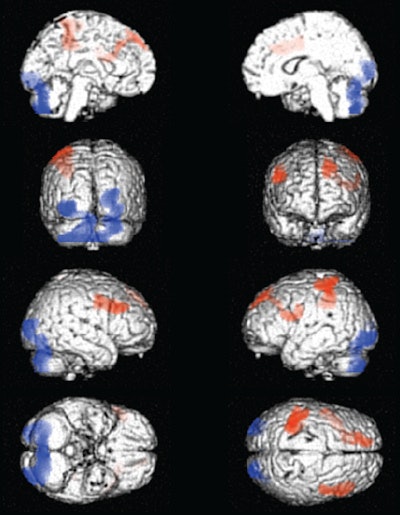 In the comparison of abstinent (left) and active (right) cocaine users, SPECT images showed areas of increased (red) and decreased (blue) perfusion. Image courtesy of Dr. Rodolfo Ferrando.
In the comparison of abstinent (left) and active (right) cocaine users, SPECT images showed areas of increased (red) and decreased (blue) perfusion. Image courtesy of Dr. Rodolfo Ferrando.There was an apparent reversal of brain dysfunction in the prefrontal cortex of now-abstinent cocaine users, according to the researchers. Compared with active users, the abstainers showed increased perfusion in the dorsolateral frontal and left parietal areas of the brain, but also decreased perfusion in the posterior occipital cortex and in the cerebellum.
The partial reversal of dysfunction in the abstinent cocaine users "may reflect an improvement in limbic balance, emotional control, and adapted behavior that is seen in abstinence subjects compared to active users," Ferrando and colleagues wrote.
"Improvement of frontal function may place the subjects in a better position to decide what is best for themselves and their future over the immediate reward the drugs can offer," Ferrando said. "In other words, these images show how the brain of the abstinent subject can gradually retrieve the necessary tools to stay away from drugs."
Because dysfunction was still present in certain areas of abstinent subjects' brains, the abnormalities should be evaluated over a long period of time to determine if complete reversibility can be achieved, the researchers added.
"This is a long process that takes many months, probably not less than a year, because some areas of the reward system still are dysfunctional in our patients when compared to normal controls," Ferrando said.
Ferrando and colleagues currently are working to define these periods more precisely and are looking for correlations with severity of craving and behavioral changes. Treatment strategies and rehabilitation programs should take into account these periods of time to increase the probability of success, they advocated.




